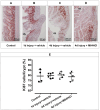M64HCl, a focal adhesion kinase activator, promotes intestinal mucosal healing in rats
- PMID: 40340802
- PMCID: PMC12063223
- DOI: 10.1186/s12876-025-03937-5
M64HCl, a focal adhesion kinase activator, promotes intestinal mucosal healing in rats
Abstract
Background: Intestinal mucosal injury may arise from various factors. While many drugs target the causative factors, none directly stimulate mucosal wound healing. We found that the specific focal adhesion kinase (FAK) activator, M64HCl, promotes intestinal mucosal healing in mice. This study aims to further validate the therapeutic impact of M64HCl on intestinal mucosal repair in rats as a second species.
Methods: Wistar rats were assigned to one of four groups: normal control, 1-day injury + vehicle, 4-day injury + vehicle, or 4-day injury + M64HCl. Intestinal injury was induced by serosally applying 75% acetic acid. Immediately after injury, rats received either a continuous infusion of M64HCl (25 mg/kg/day) or its vehicle (saline). Four days post-injury, blood was drawn to measure M64HCl levels and assess liver and kidney function. The intestines were removed and opened, ulcer areas were photographed for size quantification, and tissues were fixed for histological and immunohistochemical analysis.
Results: M64HCl substantially reduced ulcer area on gross examination, while histological analysis showed alleviation of pathological changes with M64HCl treatment. Immunohistochemical analysis confirmed increased immunoreactivity for phosphorylated FAK in the epithelium adjacent to the injury in M64HCl-treated rats. However, there was no change in the percentage of Ki67-positive cells in each crypt at the edge of the ulcer area. Serum creatinine, ALT, and AST levels did not differ between the 4-day injury groups with or without M64HCl treatment.
Conclusions: M64HCl, a water-soluble FAK activator, promotes acetic acid-induced ulcer healing in rats and may be useful in treating gastrointestinal mucosal injury.
Keywords: Focal adhesion kinase; Mucosal healing; Small intestine, mucosal injury.
© 2025. The Author(s).
Conflict of interest statement
Declarations. Ethics approval and consent to participate: All experimental procedures involving animals were approved by the Institutional Animal Care and Use Committee (IACUC) of Northeast Ohio Medical University, with IACUC number 23-04-366. The experiments were conducted in accordance with relevant guidelines and regulations. Consent for publication: Not applicable. Competing interests: The University of North Dakota and the University of Minnesota have filed two patent applications on the use of small-molecule FAK activators to promote mucosal healing. MDB and VJG are listed as co-inventors, and one also includes RGM.
Figures




Similar articles
-
A novel drug-like water-soluble small molecule Focal Adhesion Kinase (FAK) activator promotes intestinal mucosal healing.Curr Res Pharmacol Drug Discov. 2022 Dec 23;4:100147. doi: 10.1016/j.crphar.2022.100147. eCollection 2023. Curr Res Pharmacol Drug Discov. 2022. PMID: 36632414 Free PMC article.
-
Sustained intestinal epithelial monolayer wound closure after transient application of a FAK-activating small molecule.PLoS One. 2024 Aug 16;19(8):e0304010. doi: 10.1371/journal.pone.0304010. eCollection 2024. PLoS One. 2024. PMID: 39150901 Free PMC article.
-
Small molecule FAK activator promotes human intestinal epithelial monolayer wound closure and mouse ulcer healing.Sci Rep. 2019 Oct 11;9(1):14669. doi: 10.1038/s41598-019-51183-z. Sci Rep. 2019. PMID: 31604999 Free PMC article.
-
Focal Adhesion Kinase and Colony Stimulating Factors: Intestinal Homeostasis and Innate Immunity Crosstalk.Cells. 2024 Jul 11;13(14):1178. doi: 10.3390/cells13141178. Cells. 2024. PMID: 39056760 Free PMC article. Review.
-
Polysaccharides in natural products that repair the damage to intestinal mucosa caused by cyclophosphamide and their mechanisms: A review.Carbohydr Polym. 2021 Jun 1;261:117876. doi: 10.1016/j.carbpol.2021.117876. Epub 2021 Mar 1. Carbohydr Polym. 2021. PMID: 33766363 Review.
References
-
- Hu X, Yuan X, Zhang G, et al. The intestinal epithelial-macrophage-crypt stem cell axis plays a crucial role in regulating and maintaining intestinal homeostasis. Life Sci. 2024;344:122452. - PubMed
-
- Tai FWD, McAlindon ME. NSAIDs and the small bowel. Curr Opin Gastroenterol. 2018;34(3):175–82. - PubMed
-
- Goddard AF, James MW, McIntyre AS, Scott BB. Guidelines for the management of iron deficiency anaemia. Gut. 2011;60(10):1309–16. - PubMed
MeSH terms
Substances
Grants and funding
LinkOut - more resources
Full Text Sources
Miscellaneous

